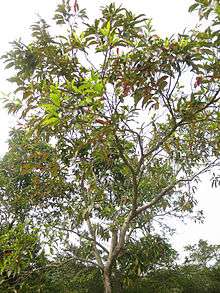Cleistocalyx operculatus
| Cleistocalyx operculatus | |
|---|---|
 | |
| As seen in Hong Kong Wetland Park | |
| Scientific classification | |
| Kingdom: | Plantae |
| (unranked): | Angiosperms |
| (unranked): | Eudicots |
| (unranked): | Rosids |
| Order: | Myrtales |
| Family: | Myrtaceae |
| Genus: | Cleistocalyx |
| Species: | C. operculatus |
| Binomial name | |
| Cleistocalyx operculatus | |
Cleistocalyx operculatus, also known as C. nervosum (DC.) Kosterm., Eugenia operculata Roxb., 1832, Syzygium nervosum DC., 1828, Syzygium operculatum (Roxb.) Nied., 1893), is a medium-sized tree of about 10 meters in height with pale brown bark and dull green leaves.
The tree is native to tropical Asia, extending as far north as Guangdong and Guangxi in China and as far south as the Northern Territory of Australia.
Description
The leaves of C. operculatus are elliptical, obovate and glaborous, measuring 7–9 cm in length.
Flowers cluster as greenish white trichomatous pannicles. The blossoms have 4 petals.
The 7–12 cm diameter fruits are ovoid with a concave tip and a wrinkled texture. The fruits turn purplish upon ripening.
Uses
The leaves and buds of C. operculatus are harvested, dried, and brewed as an herbal tea in Vietnam known as "nước vối" with stomachic properties.[1]
Gallery
- Ripen Cleistocalyx operculatus in Nepal
 Bark close-up
Bark close-up- Flower in May
References
- ↑ Nguyen, Duong Van. Medicinal Plants of Vietnam, Cambodia, and Laos. Santa Monica, CA: Mekong Printing, 1993.